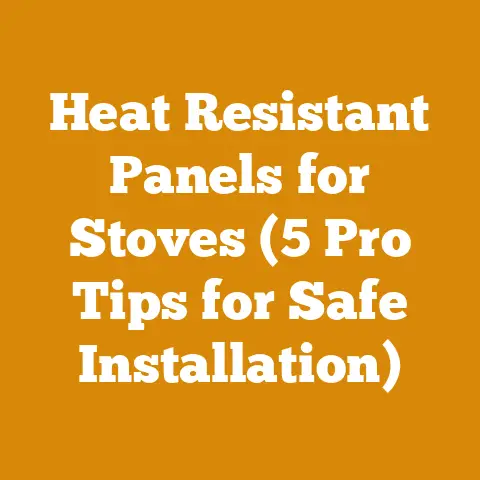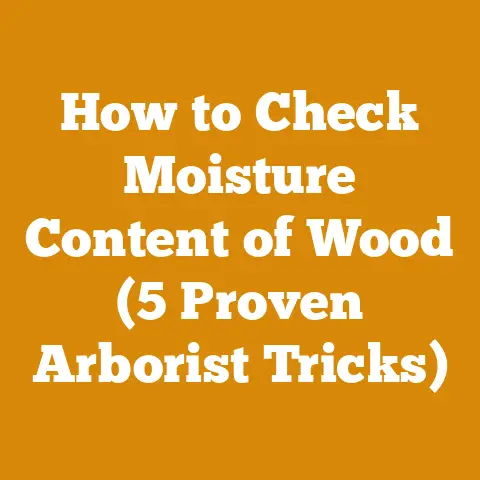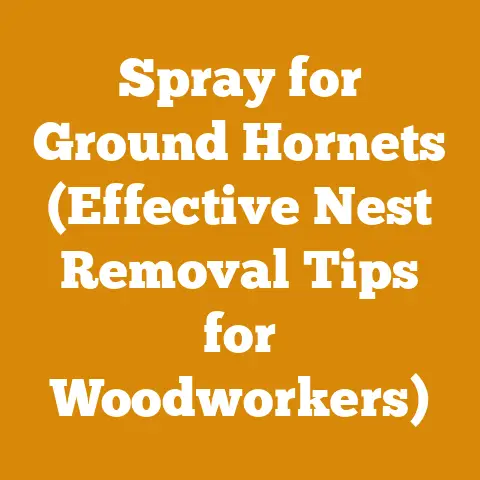How to Remove Creosote from Chimney Flue (5 Pro Arborist Tips)
Alright, let’s talk about chimney creosote. Now, I know what you’re thinking: “Creosote? Sounds like a fancy coffee drink I’d order at a ridiculously overpriced cafe.” Nope, sorry to disappoint! It’s actually the sneaky byproduct of burning wood in your fireplace or wood stove, and it’s about as welcome as a skunk at a garden party. Left unchecked, it can turn your cozy hearth into a potential inferno. So, buckle up, because I’m about to share my top 5 pro arborist tips on how to remove creosote from your chimney flue and keep your home safe and warm.
The Silent Threat: Why Creosote Removal is Non-Negotiable
Creosote. Just saying the word sends shivers down my spine, and not the good kind. As an arborist, I’ve seen firsthand the devastation that chimney fires can cause, and creosote buildup is the primary culprit. It’s a dark, tarry substance that accumulates inside your chimney flue when wood burns incompletely. Think of it as the cholesterol of your chimney – slowly clogging things up and leading to potentially catastrophic consequences.
Understanding the Creosote Conundrum
Creosote isn’t just one thing; it comes in various forms, each with its own level of danger:
- Stage 1 (Soot): This is the easiest to remove. It’s typically a light, flaky deposit.
- Stage 2 (Tar-like): This is a more serious buildup. It’s sticky and requires more aggressive cleaning.
- Stage 3 (Glazed): The most dangerous form. It’s hard, shiny, and extremely flammable. This is what turns small sparks into roaring chimney fires.
The key takeaway here? Early detection and removal are crucial. Regular chimney inspections and cleaning are your best defense against creosote buildup.
Pro Arborist Tip #1: Know Your Wood – The Foundation of Clean Burning
I can’t stress this enough: the type of wood you burn has a HUGE impact on creosote formation. Think of it this way: burning wet, unseasoned wood is like trying to run a marathon in flip-flops – you’re setting yourself up for failure.
The Moisture Content Myth: Busted!
Many people believe that any old wood will do for a fire. Not so! The moisture content of your firewood is critical. Green wood (freshly cut) can have a moisture content of 50% or higher. Ideally, you want your firewood to be below 20% moisture content for optimal burning.
Data Point: Burning wood with 20% moisture content versus 40% moisture content can reduce creosote production by up to 50%. That’s a significant difference!
My personal experience: I remember one winter helping a friend who was struggling with excessive creosote. He was burning wood he’d cut just a few weeks prior. I showed him how to properly season wood, and the difference was night and day. His chimney stayed cleaner, and his house was warmer.
Hardwood vs. Softwood: The Great Debate
While both hardwoods and softwoods can be used for firewood, hardwoods generally burn hotter and longer, producing less creosote. This is because they are denser and have a lower resin content.
Comparison Table:
| Feature | Hardwood (e.g., Oak, Maple) | Softwood (e.g., Pine, Fir) |
|---|---|---|
| Density | Higher | Lower |
| Resin Content | Lower | Higher |
| Burning Time | Longer | Shorter |
| Creosote Prod. | Lower | Higher |
Actionable Tip: Invest in a moisture meter. It’s a small investment that can save you a lot of headaches (and potential chimney fires) down the road. Aim for that magic number: below 20% moisture content.
Pro Arborist Tip #2: Choose Your Weapon – Selecting the Right Chimney Cleaning Tools
Okay, so you’ve got your seasoned wood, and you’re ready to tackle that creosote. But hold your horses! You can’t just go at it with any old brush. Choosing the right tools is essential for effective and safe creosote removal.
The Chimney Sweep Starter Pack
Here’s what you’ll need to get started:
- Chimney Brush: This is your primary weapon. Choose a brush that’s the correct size and shape for your flue. Wire brushes are best for masonry chimneys, while poly brushes are suitable for metal flues.
- Extension Rods: These allow you to reach the entire length of your chimney. Make sure they’re sturdy and flexible.
- Drop Cloths/Plastic Sheeting: Protect your hearth and surrounding area from falling debris. Trust me, creosote is messy stuff.
- Dust Mask and Eye Protection: Essential for protecting yourself from harmful particles.
- Shop Vac with HEPA Filter: For cleaning up the mess. A regular vacuum cleaner won’t cut it.
- Chimney Inspection Mirror: To inspect your chimney before and after cleaning.
Rotary Chimney Cleaning Systems: The Power-Up
For more stubborn creosote buildup, especially Stage 2 and Stage 3, consider a rotary chimney cleaning system. These systems use a drill-powered brush to scrub the flue clean. They’re more expensive than traditional brushes, but they can be incredibly effective.
Case Study: I once worked on a property where the chimney had a severe Stage 3 creosote buildup. Traditional brushing wasn’t cutting it. We used a rotary cleaning system, and it completely removed the glazed creosote, restoring the chimney to a safe condition.
Tool Maintenance Best Practices: Always clean your chimney brush and rods after each use. Store them in a dry place to prevent rust and corrosion. Replace worn-out brushes and rods to ensure optimal performance.
Pro Arborist Tip #3: The Art of the Sweep – Mastering the Chimney Cleaning Technique
Now that you’ve got the right tools, it’s time to get your hands dirty (literally!). Chimney cleaning is a methodical process that requires patience and attention to detail.
Top-Down vs. Bottom-Up: The Age-Old Debate
There are two main approaches to chimney cleaning: top-down and bottom-up.
- Top-Down: This involves cleaning the chimney from the roof down. It’s generally considered the most effective method, as gravity helps to remove the creosote.
- Bottom-Up: This involves cleaning the chimney from inside the house. It’s a good option if you’re uncomfortable working on the roof.
I personally prefer the top-down approach, as it allows for a more thorough cleaning. However, both methods can be effective if done correctly.
The Step-by-Step Guide to Chimney Cleaning
- Preparation is Key: Cover your hearth and surrounding area with drop cloths or plastic sheeting. Wear your dust mask and eye protection.
- Inspect the Chimney: Use a chimney inspection mirror to assess the condition of the flue. Note the type and amount of creosote buildup.
- Assemble Your Brush and Rods: Attach the chimney brush to the first extension rod. Add additional rods as needed to reach the entire length of the chimney.
- Start Scrubbing: Using a firm, even pressure, scrub the entire flue from top to bottom. Overlap your strokes to ensure complete coverage.
- Remove the Debris: Once you’ve finished scrubbing, remove the brush and rods. Use a shop vac with a HEPA filter to clean up the debris from the hearth and flue.
- Inspect Again: Use the chimney inspection mirror to check your work. Make sure you’ve removed all the creosote buildup.
Practical Tip: When cleaning from the top down, use a rope to lower the brush and rods into the chimney. This will prevent them from falling and potentially damaging your flue.
Pro Arborist Tip #4: Creosote Control – Prevention is Better Than Cure
Cleaning your chimney is essential, but it’s even better to prevent creosote buildup in the first place. Here are some strategies to keep your chimney clean and your fires burning safely:
Burn Hot, Burn Clean
The key to preventing creosote is to burn hot, clean fires. This means using seasoned wood, providing adequate airflow, and avoiding smoldering fires.
Wood Science Insight: When wood burns incompletely, it releases volatile organic compounds (VOCs) that condense in the chimney flue, forming creosote. Burning hot fires ensures that these VOCs are completely combusted, reducing creosote production.
Proper Airflow: The Breath of Life for Your Fire
Make sure your wood stove or fireplace has adequate airflow. Open the damper fully when starting a fire, and adjust it as needed to maintain a strong, steady flame.
Firewood Seasoning Techniques and Safety Considerations:
- Stacking Matters: Stack your firewood in a single row, with space between each piece for airflow.
- Sun and Wind: Choose a location that’s exposed to sun and wind. This will help to dry the wood more quickly.
- Elevation: Elevate your firewood off the ground to prevent moisture from wicking up from the soil.
- Covering is Key: Cover the top of the woodpile to protect it from rain and snow, but leave the sides open for airflow.
- Safety First: Wear gloves and eye protection when handling firewood. Watch out for insects and spiders.
Chemical Creosote Removers: A Helping Hand?
Chemical creosote removers can help to loosen creosote buildup, making it easier to remove with a brush. However, they’re not a substitute for regular chimney cleaning.
Warning: Always follow the manufacturer’s instructions carefully when using chemical creosote removers. Some products can be corrosive and may damage your chimney flue.
Pro Arborist Tip #5: Call in the Pros – When to Seek Professional Help
While DIY chimney cleaning can be effective for light creosote buildup, there are times when it’s best to call in a professional chimney sweep.
Signs You Need a Pro
- Heavy Creosote Buildup: If you have a significant amount of creosote buildup, especially Stage 2 or Stage 3, it’s best to leave it to the professionals.
- Damaged Chimney: If your chimney is damaged or deteriorating, a professional can assess the damage and make repairs.
- Chimney Fires: If you’ve had a chimney fire, it’s essential to have your chimney inspected and cleaned by a professional before using it again.
- Uncertainty: If you’re unsure about any aspect of chimney cleaning, it’s always best to err on the side of caution and call a professional.
Industry Statistics: According to the National Fire Protection Association (NFPA), chimney fires are a leading cause of home fires in the United States. Regular chimney inspections and cleaning can significantly reduce the risk of chimney fires.
Finding a Qualified Chimney Sweep
When choosing a chimney sweep, look for someone who is certified by the Chimney Safety Institute of America (CSIA) or the National Chimney Sweep Guild (NCSG). These organizations provide training and certification to ensure that chimney sweeps are qualified to perform their work safely and effectively.
Project Planning and Execution:
- Get a Quote: Contact several chimney sweeps and get a written quote for the work.
- Ask for References: Ask for references from previous customers.
- Check Credentials: Verify that the chimney sweep is certified by the CSIA or NCSG.
- Schedule the Appointment: Schedule the appointment at a time that’s convenient for you.
- Prepare Your Home: Clear the area around your fireplace or wood stove and cover any furniture that could be damaged by soot or debris.
Final Thoughts: Keeping Your Home Safe and Warm
Removing creosote from your chimney flue is a crucial task for any homeowner who uses a fireplace or wood stove. By following these 5 pro arborist tips, you can keep your chimney clean, your home safe, and your fires burning brightly. Remember, prevention is always better than cure, so burn seasoned wood, maintain proper airflow, and schedule regular chimney inspections and cleaning. And when in doubt, don’t hesitate to call in the pros. After all, a safe and cozy home is worth its weight in gold.






